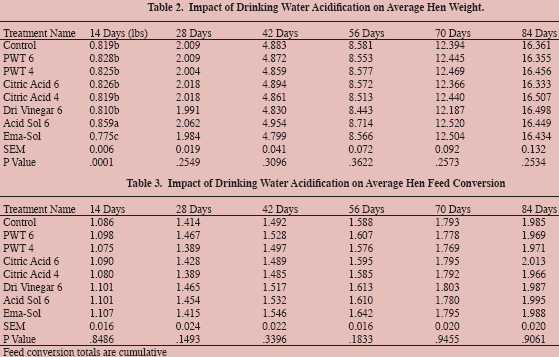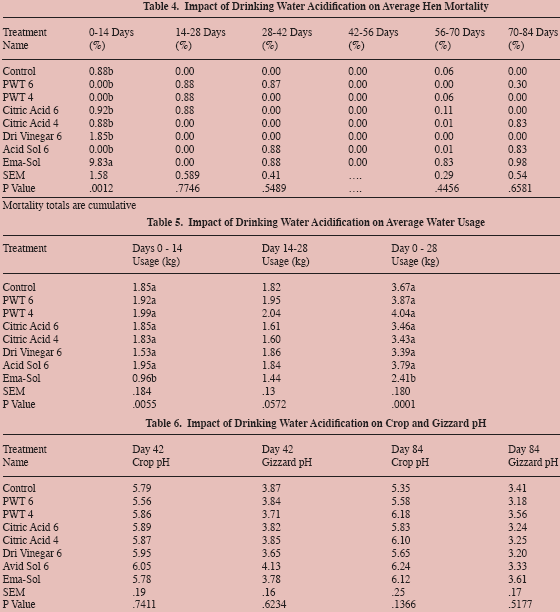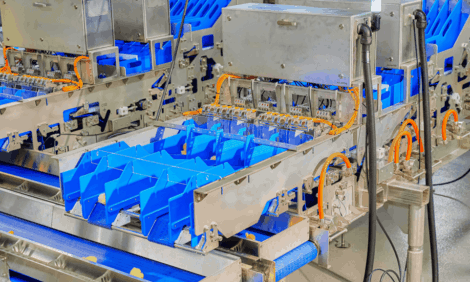



Effects of Water Acidification on Turkey Performance
By Jana Cornelison, Melony Wilson and Susan Watkins, Cooperative Extension Service at the University of Arkansas's Avian Advice - Acidification of the drinking water has become very popular in the broiler industry as a tool for improving bird performance. However, little is known about the exact effects of water acidification on weight gains, feed conversion efficiency and livability for turkey production.Introduction
| The Author | |
 Dr. Susan Watkins Extension Poultry Specialist |
|
In addition, little documentation exists which compares different drinking water pH adjustment products for turkeys. Therefore a trial was conducted to determine how turkeys respond to different products used to adjust the drinking water pH.
Materials and Methods
Nine hundred and sixty turkey hen
poults (day-old) were randomly placed in
48 floor pens to give 20 birds/pen and six
replications per treatment. Each pen was
equipped with one hanging tube feeder
and a water plasson. Each pen had its own
water supply via a 5 gallon sealed bucket.
Plassons were cleaned every day and water
usage was measured for the first 28 days.
This measurement involved accounting for
the water added to each pen as well as the
water removed each time the plassons were
cleaned. Seven treatments were compared
to a control (Fayetteville city water). The
treatments (outlined in Table 1) included PWT
(Jones-Hamilton Co., Walbridge, OH) added
to the control water to an adjusted pH of 4
and 6, I.D. Russell Citric Acid (Alpharma,
Fort Lee, NJ) added to the water to adjust the
pH to 4 and 6, Dri Vinegar (BVS, (Willmar,
MN)) added to the water to adjust the pH to
6, Acid Sol (BVS, Willmar, MN)) added to
the water to adjust the pH to 6 and Ema-Sol
(Alpharma, Fort Lee, NJ) added to the water
to adjust the pH to 4. Each solution was
prepared in a 50 gallon container and then
dispersed to the corresponding replicate pens.
Each container was filled with Fayetteville
city water and allowed to sit over night to
allow residual chlorine to dissipate. Prior to
the preparation of each solution a hand-held
pH meter was first standardized using pH
4, 7 and 10 buffer solutions. The pH was
continuously checked as each solution was
slowly mixed to the desired pH. To enhance
the dissolving of the dry products, PWT and
citric acid, concentrated stock solutions of
each was prepared in room temperature water.
This concentrated solution was slowly stirred
into the appropriate treatment container until
the desired pH was achieved. Fresh solutions
were made at lease twice weekly and more
frequently during the last four weeks of the
trial. The pH was verified and recorded, as
each batch was prepared. All water and
feed added to the pens was weighed. Birds
received a commercial diet regime supplied
by Cargill. Diets were changed every two
weeks.
The birds were group weighed by pen at
day 1 and then individually weighed on days
14, 28, 42, 56, 70 and 84. Feed consumption
was measured for each period. Pens were
checked twice daily for mortality. The
weight of all dead and cull birds was recorded
for use in determining an adjusted feed
conversion rate. At week six and twelve, one bird per pen was
weighed and sacrificed by suffocation with carbon dioxide.
The pH of the crop and gizzard was measured by emptying
approximately 20 grams if the contents and blending with an
equal amount of distilled, de-ionized water.
Results were analyzed using the GLM procedure of
SAS. Pens served as the experimental unit. The mortality
percentage data was transformed using square root
transformation to normalize the distribution. All means which
were statistically significant at the P<. 05 level were separated
using the repeated t-test. The feed-conversion rates were
calculated as cumulative values. The mortality was calculated
for each weigh period.

Results
The average body weights of the hens are shown in
Table 2. At day 14 the hens receiving the Acid Sol were
significantly heavier and the hens receiving the Ema-Sol
adjusted to a pH of 4 were significantly lighter than all of the
birds receiving the other treatments and the control water. At
this time the decision was made to raise the Ema-Sol treatment
pH to 6. By day 28 there were no significant differences in
body weight and this trend remained throughout the remainder
of the trial.
Though not significant, the hens receiving the
Ema-Sol water lagged behind slightly in weight through day
56 but by day 70 the Ema-Sol birds had similar body weights
to the other treatments. Again while not significant, it is
interesting to note that the birds receiving the PWT 4, Citric
acid 4 or Dri Vinegar 6 treatments had the highest numerical
body weights at day 84. No statistical differences were seen
for feed conversions for any of the periods measured (Table
3). Birds receiving the Ema-Sol treatment had a significantly
higher mortality rate for the first fourteen days. However,
overall mortality remained very low and after fourteen days
there were no additional losses of Ema-Sol birds until day 56
(Table 4).

Water usage was measured through day 28. However,
since the drinkers were plasson and were cleaned daily, this
measurement can only be considered an estimation of water
usage (Table 5). For the first fourteen days water usage for the
Ema-Sol birds significantly lagged behind all other treatments.
This trend continued through day 28 and even after raising the
Ema-Sol treatment pH to 6 the birds receiving this treatment
still lagged slightly behind in consumption. At the time that
the pH of the gizzard and crop contents were to be measured,
only a small amount of dry material was found in these organs,
so an equal weight of distilled de-ionized water (pH 6.68) was
added to each sample (Table 6.). While this addition probably
influence final pH, the same amount of water added to each
sample so that the effect would be the same across all treatments. As seen in the broiler trial, the pH of the gizzard was in the 3 to
low 4 range while the crop pH was higher but did not necessarily reflect the pH of the water treatments.
Conclusion
The results of this trial indicate that lowering the pH of the drinking water with PWT, citric acid, Dri vinegar, Acid Sol and
Ema-Sol resulted in turkey hen performance similar to the birds receiving the control water. Starting the poults on Ema-Sol
adjusted to a pH of 4 resulted in a significantly higher mortality and reduced weights through day 14. The pH of the Ema-
Sol treatment was then raised to 6 for the remainder of the trial and the birds had final weights statistically similar to the birds
receiving the other treatments.

Source: Avian Advice - Spring 2005 - Volume 7, Number 2










